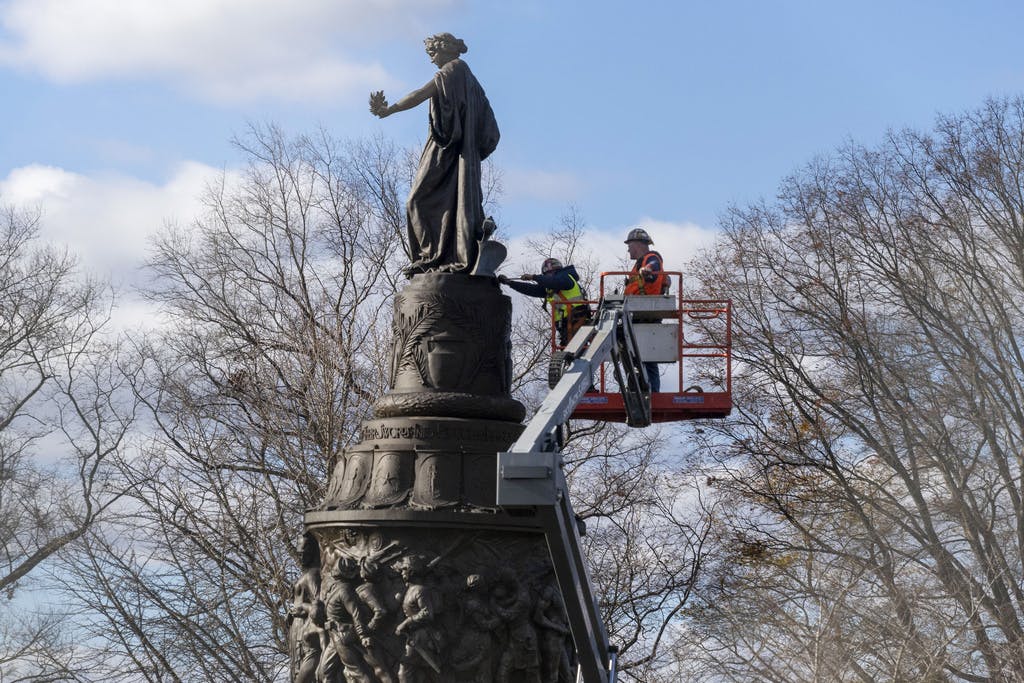Arlington Confederate Monument, Raised for Reconciliation, Can Now Serve America by Falling
Memorial to come down amid the frenzy to tear down statues and other memorials to those who lost the Civil War.

A judge is allowing the removal of the memorial to Confederate war dead at Arlington National Cemetery. The demolition is an opportunity to teach history and ponder if a monument raised in the name of national reconciliation may, in coming down, advance that noble purpose again.
The lawsuit that stayed the congressionally mandated demolition, filed by Defend Arlington, argued that removal would “desecrate, damage, and likely destroy” the memorial. A United States district judge, Rossie Alston Jr., lifted the halt, saying the group hadn’t shown that the edifice is in the public interest. Touring the site, he could discern “no desecration of any graves.”
Amid a frenzy to tear down monuments, many stand against all wrecking balls targeting America’s past. A Democrat of Virginia, Senator Webb, said removing the 1914 memorial represents an “atrophied understanding of the Civil War itself.”
Opponents argued that dismantling the memorial would foster understanding of a sort more relevant to today. Few on any side consider just why the victors, who paid the price in blood to defeat the Confederacy, honored the other side’s dead at all.
“One only has to read the history of rebellions in other countries,” the Sun wrote in 1870, after supporting emancipation from the paper’s fourth issue, “to learn that the leniency extended to our insurgents has no parallels in other nations.”
In 1994, Shelby Foote described the legacy of that forgiveness. It consisted “of Southerners admitting — freely — that it’s probably best that the Union wasn’t divided. And the North admits — rather freely — that the South fought bravely for a cause in which it believed, and that is a great compromise. And we live with that and that works for us.”
At least it worked until recent years, when Confederate symbols became a rallying cry for those embracing the myth of the “Lost Cause.” Black Americans, suffering violence at their hands, objected to the price their ancestors paid to ensure a domestic tranquility that they were denied.
Acts of kindness such as the monument at Arlington did indeed coax those who had lost fathers, sons, brothers, and comrades back to the old flag. It helped, as President Lincoln said in his second inaugural, “to bind up the nation’s wounds.”
Black Americans are mindful of how those who never accepted Dixie’s defeat exploited the North’s leniency to subjugate them once again, seeking to nullify the Union’s triumph and frustrate emancipation.
Soon after the guns fell silent, the Democratic Party — through Jim Crow laws and Ku Klux Klan terrorism — began driving Black Republicans representing their states from Congress and the freedmen away from the polls. Threatening “the South Shall Rise Again,” they erected monuments not for reconciliation, but as thumbs in the eyes of citizens once enslaved.
Despite the romance many have for acts of reconciliation like the Arlington monument, it’s also little remembered among the current debate that the estate became a cemetery not as an act of magnanimity but as retribution and spite.
Arlington was the home of the Confederacy’s commanding general, Robert E. Lee. By 1864, when Lincoln visited, it was in the hands of the Union Army. A story, perhaps apocryphal, has him seeing war dead being loaded into carts and, with Union graveyards overflowing, in search of new plots.
Quartermaster General Montgomery Meigs, whether acting on Lincoln’s orders or not, solved the problem and struck a blow against Lee for leading the secession. He began burying the dead in Mrs. Lee’s rose garden, only yards from the house.
Four score and four years before that first shovel hit the dirt, laying to rest Private William Christman, General Benedict Arnold also betrayed America. Unlike Lee, he was given no honors in death. Patriots even defaced the headstones of relatives who shared his name and he’s not mentioned on New York’s Saratoga Monument, site of his greatest victory.
Colonial Americans didn’t seek reconciliation by immortalizing a traitor. By honoring those who died for the Confederacy, Americans generations later helped avoid a second Civil War and paved the way to a more perfect union by doing just that.
As today’s Americans watch the Arlington monument disappear into history, there remains work to be done binding up the nation’s wounds. We can hope that the wrecking ball will advance that mission, removing an honor to Confederate soldiers so their example in death may strengthen the union they fought to destroy in life.

